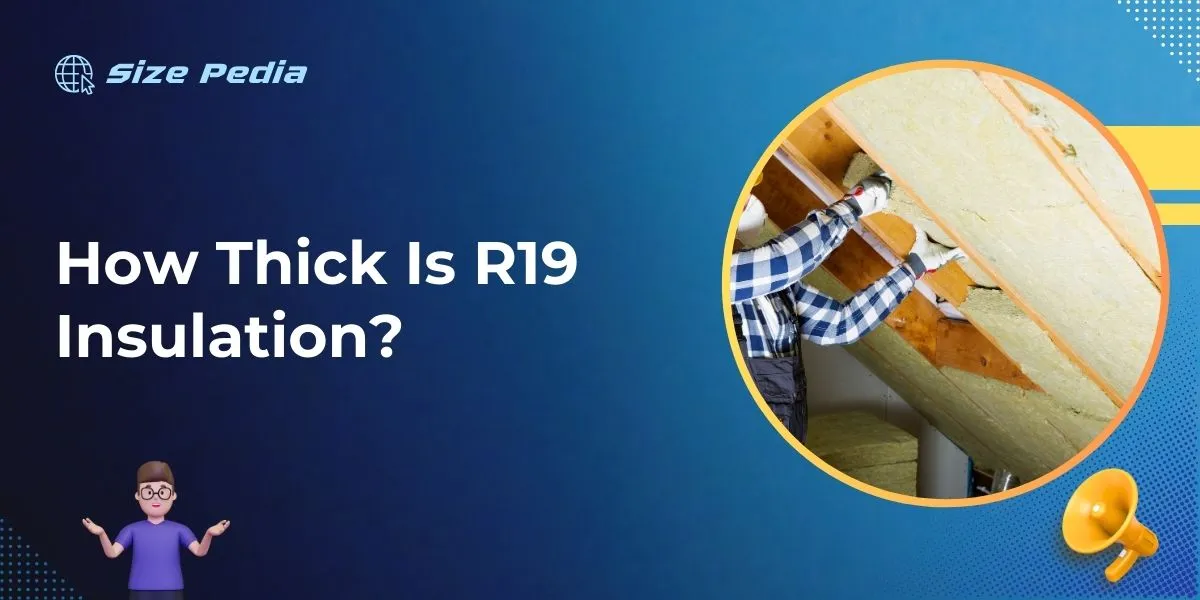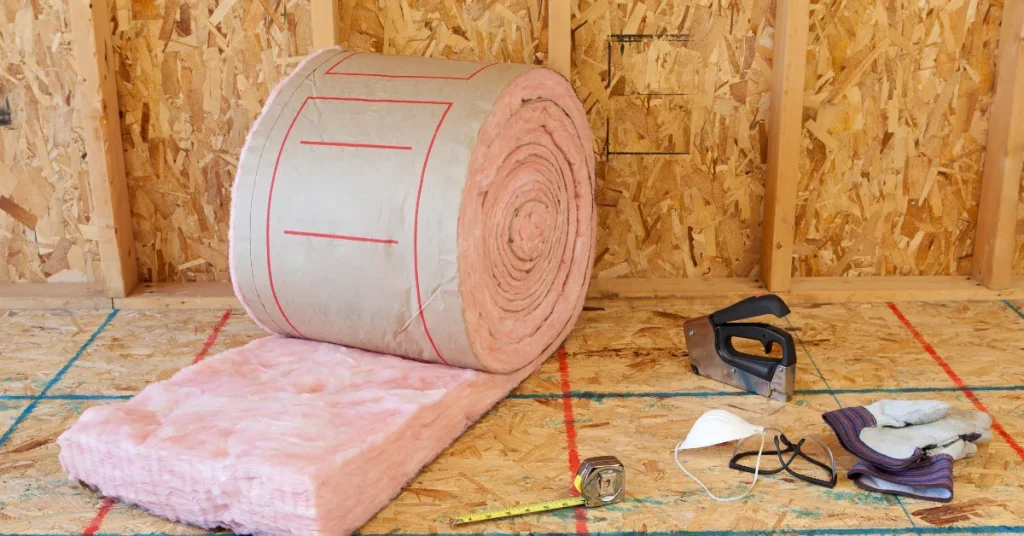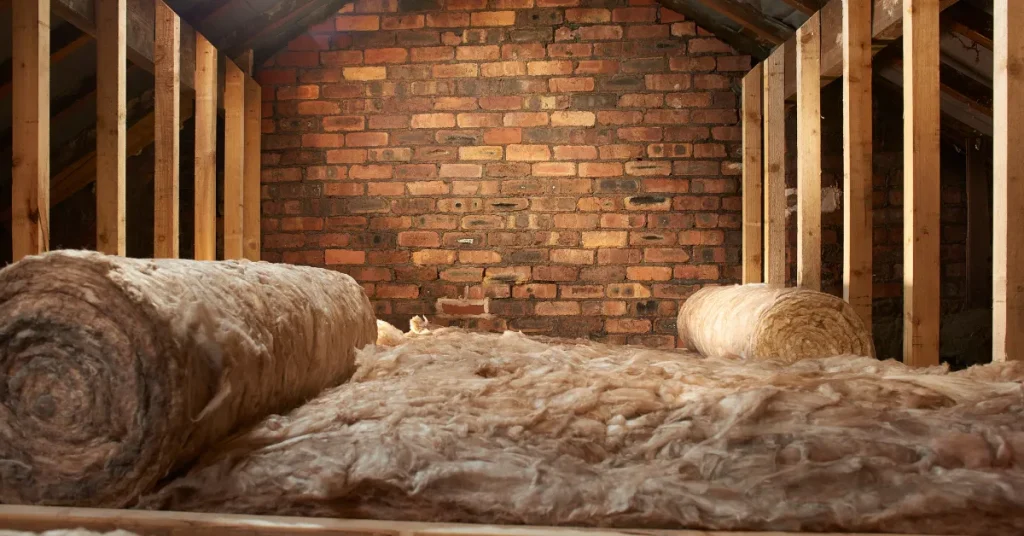R19 insulation typically measures 6.25 inches thick. This dimension is standard for certain types of fiberglass batts.
Understanding the specifications of insulation materials is crucial for homeowners and builders aiming to enhance energy efficiency.
Proper insulation thickness plays a vital role in controlling temperature and reducing energy costs in residential and commercial buildings.
R19 insulation is commonly used in walls and attic spaces, providing a balance between cost and thermal performance.
Its thickness is designed to fit standard wall cavities, which helps prevent thermal bridging and ensures the building envelope remains well-insulated.
By choosing the correct thickness, like R19, you can achieve significant savings on heating and cooling bills while creating a comfortable environment in various climate conditions.

The Basics Of R19 Insulation
R19 insulation is a go-to choice for thermal resistance in homes. Its thickness supports efficient energy use, enhancing comfort. Let’s delve into what R19 insulation is made of, how it performs, and where it does its best work.
Material Makeup And Properties
Fiberglass is the star in R19 insulation. This material boasts tiny glass fibers spun into a dense mat. Its thickness typically spans 6.25 inches. R19 stands out with a thermal resistance rating, or R-value, of 19.
- Better energy savings with high R-value
- Resistant to fire, reducing safety concerns
- Mold and moisture resistance adds to its longevity
- Sound reduction for quieter spaces
Common Applications Of R19 Insulation
With its thickness and properties, R19 finds a spot in many spaces.
| Location | Role |
| Exterior walls | Keeps heat in during winter, out during summer |
| Floors above unheated garages | Blocks cold, elevates comfort |
| Cathedral ceilings | Manages temperature without wasting space |
Particularly in colder climates, R19 insulation is a key player in energy-efficient building design.
Measuring Thickness In Insulation
Understanding how thick R19 insulation is involves more than just a number; it’s about ensuring the right degree of warmth and efficiency for homes. Insulation thickness is a critical factor in a building’s energy performance. Let’s explore how to measure this vital component.
Units And Tools For Measuring Insulation
Measuring insulation thickness requires precision. Two common units are used:
- Inches (in) for measurement in the United States.
- Millimeters (mm) or centimeters (cm) in metric systems.
For accuracy, use these tools:
| Tool | Use |
| Tape Measure | for quick measurements. |
| Ruler or Straightedge | for smaller sections. |
| Thickness Gauge | for industrial accuracy. |
Factors Influencing Insulation Thickness
Different elements affect the thickness of your R19 insulation:
- Material Density: Heavier materials might compress, affecting thickness.
- Moisture Exposure: Wet conditions can cause insulation to settle.
- Age of Insulation: Older material can degrade or compress over time.
Note: R19 insulation generally offers a thickness of 6.25 inches when uncompressed. These factors can alter actual thickness in practice.
The Specifics Of R19 Thickness
Welcome to the specifics of R19 insulation thickness, a key factor in building efficiency. Understanding insulation must occur before installation to ensure optimal performance. This section breaks down crucial knowledge for homeowners and builders alike.
R-value And Its Relationship With Thickness
R-Value measures insulation’s ability to resist heat flow. The ‘R’ stands for resistance. Higher R-Values mean better insulation and more resistance to heat transfer.
Thickness affects R-Value, but materials used matter too. Not all materials with the same thickness have similar R-Values.
Typical Thickness Range For R19 Insulation
R19 is a mid-range insulation level, common in residential and commercial buildings. The standard thickness for R19 batts is between 6 to 6.25 inches. Yet, these values can slightly vary depending on the material type.
Fiberglass, mineral wool, and cellulose are common materials for R19 insulation, each with unique thickness attributes.
| Material | Typical Thickness |
| Fiberglass | 6.25 inches |
| Mineral Wool | 6.0 inches |
| Cellulose | Varies |
- Fiberglass: Most flexible with precision cutting.
- Mineral Wool: Denser and may vary slightly.
- Cellulose: Loose-fill, not standard thickness.
Insulation’s effectiveness depends on correct installation. Compressing the material can lower R-Value. Sealing gaps maximizes performance.
Impact Of Thickness On Insulation Performance

Understanding insulation’s impact is crucial in keeping homes cozy and energy bills low. Insulation thickness can greatly affect how well it performs. This is where the R-value comes in, and for R19 insulation, thickness is key to its effectiveness.
Thermal Resistance And Energy Efficiency
R19 insulation usually measures around 6.25 inches thick. This measurement gives it a perfect balance of performance and practicality for walls and ceilings.
The thickness contributes to a higher thermal resistance, which means it can better resist heat transfer. Here’s what that means for energy efficiency:
- Reduced heat flow: The thicker the insulation, the slower the heat moves through your walls.
- Lower energy bills: Slower heat flow means your heating and cooling systems work less.
- Comfort all year: A consistent temperature stays in your home no matter the weather.
Comparing R19 To Other R-values
In comparison to other R-values, R19 sits in the middle of the spectrum, offering a blend of efficiency and cost-effectiveness. Let’s see how it stacks up against others:
| R-Value | Thickness (inches) | Performance |
| R13 | 3.5 | Good for interior walls |
| R19 | 6.25 | Great for floors and attics |
| R30 | 9.5 | Best for colder regions |
R19 insulation shines in mild to moderate climates and offers a solid performance at an attractive price. Whether you are retrofitting an existing space or building new, consider R19 for a balanced insulation solution.
Installation Best Practices
The right installation of R19 insulation is crucial for its effectiveness. Follow these best practices to ensure your R19 insulation performs optimally.
Proper installation keeps your space warm in winter and cool in summer. Becoming familiar with the installation process enhances both safety and efficiency.
Preparing For R19 Insulation Installation
Before installing R19 insulation, clear the space.
- Remove old insulation if needed.
- Check for air leaks and seal them.
- Ensure adequate ventilation in the area.
- Wear safety gear, including gloves and a mask.
- Gather all necessary tools and equipment.
Ensuring Optimal Thickness During Installation
R19 insulation is about 6.25 inches thick. To maintain this, follow these steps:
- Measure the space to determine the amount of insulation needed.
- Use a ruler to check for consistent thickness across the installation.
- Avoid compressing the insulation, as this reduces its effectiveness.
- Install in continuous layers to prevent gaps or overlaps.
- Trim insulation carefully, ensuring a snug fit around fixtures.
| Installation Step | Details |
| Measure Space | Determines insulation quantity needed. |
| Check Thickness | Ensures 6.25-inch consistency. |
| Avoid Compression | Maintains effectiveness. |
Remember, the key to a successful R19 insulation installation lies in precision. Keep these practices in mind for a well-insulated, energy-efficient space that stands the test of time.
Maintaining R19 Insulation

Insulation is key for a warm and energy-efficient home. R19 insulation is a common choice for many homeowners. It is often 6 inches thick. This thickness is perfect for keeping homes cool in summer and warm in winter.
But, insulation must stay in good shape to work well. Here’s how to maintain your R19 insulation for maximum efficiency.
Regular Inspection For Consistent Thickness
Over time, insulation can settle or become damaged. This affects its thickness and efficiency. It is important to do regular checks.
This makes sure the insulation stays at its proper 6-inch thickness. If you find areas where the insulation is thin, action is needed. Follow these steps to check your insulation:
- Visual check: Look at the insulation in your attic or walls. If it looks flat or thin, it might need replacement.
- Measure: Use a ruler to measure the thickness in different areas. If it’s less than 6 inches, consider adding more insulation.
- Touch: Feel for dampness or signs of pests. Both can damage insulation.
Upgrading Or Supplementing Existing Insulation
If your inspection shows thin or damaged insulation, you might need to upgrade. Adding new materials can help reach the desired R19 thickness. There are options for supplementing your current insulation:
| Method | Benefits |
| Batts and rolls: | Easy to add on top of existing insulation for extra thickness. |
| Blow-in insulation: | Fills in gaps for an even layer and consistent R-value. |
| Foam boards: | Adds rigidity and extra insulation in specific areas. |
Choose materials that match your current insulation. This ensures the best performance. Consider a professional for precise installation. Well-installed insulation keeps your home comfy and saves on energy bills.
FAQs About How Thick Is R19 Insulation
How Thick Should R19 Insulation Be?
R19 insulation typically measures 6. 25 inches in thickness. This standard size efficiently fits within various wall cavities and framing spaces.
Can R-19 Insulation Be Used In 2×4 Walls?
R-19 insulation is typically too thick for standard 2×4 walls, which generally accommodate R-13 to R-15 insulation.
What Do You Use R19 Insulation For?
R19 insulation is typically used in residential walls, floors, and ceiling applications to enhance thermal efficiency and reduce energy costs. It is most effective in moderate to cold climates.
How Thick Is R19 Roll Insulation?
R19 roll insulation typically measures 6. 25 inches in thickness. This provides effective thermal resistance for various building applications.
Conclusion
Wrapping up, R19 insulation typically measures 6. 25 inches in thickness. This information is crucial for ensuring proper thermal regulation in residential and commercial spaces.
Remember, correct installation maximizes energy efficiency, keeping your spaces comfortable and your bills low. Choose R19 for a cozy, cost-effective environment.
Resources:
1. https://www.energy.gov/sites/prod/files/guide_to_home_insulation.pdf
